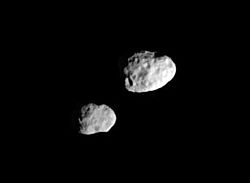 Janus, as imaged by Cassini before Saturn in 2006 | |
| Discovery | |
|---|---|
| Discovered by | Audouin Dollfus |
| Discovery date | December 15, 1966 |
| Designations | |
| Adjective | Janian |
| Epoch December 31, 2003 (JD 2 453 005.5) | |
| Semi-major axis | 151 460 ± 10 km |
| Eccentricity | 0.0068 |
| Orbital period | 0.694 660 342 d |
| Inclination | 0.163 ± 0.004° to Saturn's equator |
| Satellite of | Saturn |
| Physical characteristics | |
| Dimensions | 193×173×137 km [2] |
| Mean radius | 89.4 ± 3.0 [2] |
| Mass | 1.912 ± 0.005 ×1018 kg [1] |
| Mean density | 0.64 ± 0.06 g/cm³[2] |
| Equatorial surface gravity | ~0.0137 m/s2 |
| Rotation period | synchronous |
| Axial tilt | zero |
| Albedo | 0.71 ± 0.02 (geometric)[3] |
Janus (pronounced /ˈdʒeɪnəs/,[4] or as in Latin Ianus) is an inner satellite of Saturn. It is also known as Saturn X (Roman numeral X = 10). It is named after the mythological Janus.
Discovery and orbit
- The following is a summary. For more detailed information about Janus and Epimetheus' unusual shared orbit, see Epimetheus.
Janus occupies essentially the same orbit as the moon Epimetheus. This caused some confusion for astronomers, who assumed that there was only one body in that orbit, and for a long time struggled to figure out what was going on. It was eventually realized that they were trying to reconcile observations of two distinct objects as a single object.
The discovery of Janus is attributed to its first observer: Audouin Dollfus, on December 15, 1966.[5] The new object was given the temporary designation S/1966 S 2. Previously, Jean Texereau had photographed Janus on October 29, 1966 without realising it; Dollfus named it at the same occasion.[6] On December 18, Richard Walker made a similar observation which is now credited as the discovery of Epimetheus.[7]
Twelve years later, in October 1978, Stephen M. Larson and John W. Fountain realised that the 1966 observations were best explained by two distinct objects (Janus and Epimetheus) sharing very similar orbits.[8] Voyager 1 confirmed this in 1980.[9] (See below for a more detailed description of their unique arrangement.)
Janus was observed on subsequent occasions and given different provisional designations. It was observed by the Pioneer 11 probe when it passed near Saturn on September 1, 1979: three energetic particle detectors observed its "shadow" (S/1979 S 2.[10]) Janus was observed by Dan Pascu on February 19, 1980 (S/1980 S 1,[11]) and then by John W. Fountain, Stephen M. Larson, Harold J. Reitsema and Bradford A. Smith on the 23rd (S/1980 S 2.[12])
All of these people thus share, to various degrees, the title of discoverer of Janus.
Name
Janus is named after Janus, the two-faced Roman god. Although the name was informally proposed soon after the initial 1966 discovery,[6] it was not officially given this name until 1983.[13] Epimetheus received its name at the same time.
According to the OED, the adjectival form of the moon's name is Janian.
Orbital relationship between Epimetheus and Janus

Janus and Epimetheus are co-orbital: Janus' mean orbital radius from Saturn is currently only 50 km less than that of Epimetheus. This is smaller than either moon's diameter. Since closer orbits have higher velocities, the two moons must inevitably approach each other, and it would seem at first glance that a collision would be inevitable. But as the inner moon catches up with the outer moon their mutual gravitational attraction boosts the inner moon's momentum and raises its orbit, causing it to slow down. At the same time, the outer moon equally loses momentum and drops into a lower orbit. The moons thus "trade" orbits and begin to move apart again, since the forward moon is now in the lower, faster orbit. The nearest they ever approach is some 10 000 km. The exchange takes place about once every four years; the last close approach was on January 21, 2006,[14] the next will be in 2010. At that time, Janus' orbital radius will increase by ~20 km, while Epimetheus' decreases by ~80 km; Janus' orbit is less affected because it is 4 times more massive than Epimetheus. As far as it is currently known, this arrangement is unique in the solar system.
The orbital relationship between Janus and Epimetheus can be understood in terms of the circular restricted three-body problem, as a case in which the two moons (the third body being Saturn) are similar in size to each other. Other examples of the three-body problem include the Lagrangian points, Trojan asteroids and Trojan moons, the "horseshoe" orbit of Cruithne with respect to Earth, and potentially dozens of other objects in similar orbits.[15]
Physical characteristics
Janus is extensively cratered with several craters larger than 30 km but few linear features. The Janian surface appears to be older than Prometheus' but younger than Pandora's. From its very low density and relatively high albedo, it seems likely that Janus is a very porous and icy rubble pile.
Ring
A faint dust ring is present around the region occupied by the orbits of Janus and Epimetheus, as revealed by images taken in forward-scattered light by the Cassini spacecraft in 2006. The ring has a radial extent of about 5000 km.[16] Its source is particles blasted off the moons' surfaces by meteoroid impacts, which then form a diffuse ring around their orbital paths.[17]
Gallery
| Janus and Prometheus lie above and below Saturn's rings in this Cassini image from 2006-04-29. | Janus as viewed by Voyager 2 on 1981-08-25. |



0 comments:
Post a Comment